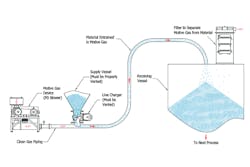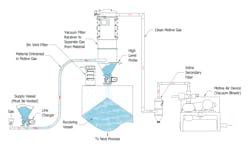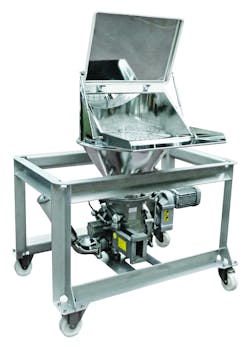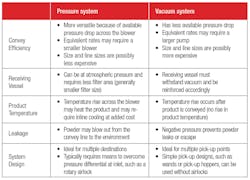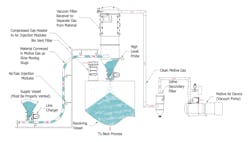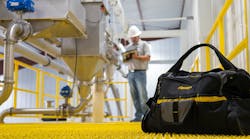Today’s processed food manufacturers are constantly searching for methods to improve process efficiency, changeover times and, of course, ensure product safety. One of the key technologies that can help address and improve these factors is pneumatic conveying, regardless of whether it is for the raw ingredients (major and minor), ingredient blends prior to their next process step or final product prior to packaging.
By properly selecting the best method for the application, a much more cost-effective and reliable means of material handling can be achieved. This article outlines and defines the methods of pneumatic conveying available for a variety of unit operations in food processing.
Pneumatic transfer — vacuum or pressure?
Food manufacturing facilities typically include several pneumatic conveying types. The mode of transfer of raw ingredients or final product is dependent upon many process parameters including material characteristics, distance to be transferred, required rate of transfer, friability of product and segregation concerns. It is therefore important when choosing the conveying method that a full examination of several process parameters be completed since different options can result in cost savings and efficiency improvements.
Positive pressure systems, as shown in Figure 1 (above), are typically used to convey bulk materials from a single source to one or multiple destinations. This is done by use of a positive displacement blower blowing into material entry points located downstream. These entry points then meter each product into the conveying line by means of a rotary airlock valve, which maintains the pressure differential between the ambient atmosphere and that of the conveying line. Material and air blown through the line exit at single- or multiple-use points where they are separated by means of a filter receiver or cyclone separator or are fed directly into process vessels.
Positive pressure conveying systems are typically used to transport product over long distances and at high throughputs. Applications that involve pressure conveying often include loading and unloading of large volume vessels such as silos, bins, railcars, trucks and bulk bags.
Figure 2. Typical dilute-phase vacuum system
Conversely, negative pressure or vacuum systems, as shown in Figure 2, are generally used for transporting material from multiple sources — such as storage vessels, process equipment, bulk bags, trucks and railcars — to individual or multiple destinations and are used for lower volumes and shorter distances.
Image 1. Sanitary design bag dump station
Negative pressure is created by a positive displacement vacuum blower located at the downstream end of the system. Material can enter the system via bag dump stations equipped with rotary airlock valves, (see Image 1) handheld pickup wands and pickup hoppers. Material exits the system through filter receivers that separate the material from the conveying air directly above process equipment, surge hoppers, storage vessels or other discharge points.
One of the advantages of vacuum systems is the inward suction created by the vacuum blower and the reduction of any outward leakage of dust. This is one of the reasons vacuum systems are often used in highly sanitary or dust-containment applications. Another advantage of vacuum systems is the simple design for multiple pickup points. Table 1 outlines just a few of the comparative differences when choosing between positive-pressure or negative-pressure (vacuum) conveying systems.
Table 1. Comparison of positive pressure versus vacuum conveying
Dense phase or dilute phase conveying?
In addition to the choice of positive or negative pressure, conveying systems are also available in a dilute or dense phase of operation. By definition, dense phase systems convey material below or significantly below the product saltation velocity.¹ This low-velocity
conveying creates a higher product-to-gas ratio — a smaller amount of gas is used to move the same or larger quantities of product. In general, the less gas required, the less power consumed by the pneumatic conveying system.
Because of the lower gas velocity produced with dense-phase conveying, a much slower, gentler conveying action on the material. This gentle action also reduces segregation and attrition issues often experienced with the more aggressive dilute-phase operation. For these reasons, in food operations, dense-phase conveying is often used to convey the pre-blends before going to the next process step as well as the final products going to packaging.
Figure 3. Typical dense-phase vacuum system PHS
Dense-phase vacuum systems
Dense phase can be used in vacuum systems, as illustrated in Figure 3. Dense-phase vacuum has a limitation on conveying distance — 60 to 90 meters (200 to 300 feet) — based on the energy that can be produced by a vacuum blower or pump. This method is also very well suited to fragile and/or sticky materials because the material is pulled through the convey line rather than pushed, as in a pressure system.
The bulk material moves in the form of compact slugs. The slugs form naturally after entering the convey line via the rotary valve feeder or vacuum pickup adapter. Regular fluctuation of the conveying vacuum is normal in order to achieve stable slug formation.
The system operates at high vacuum and low air flow with a high material-to-air ratio and conveys at velocities well below the saltation velocity of the material, resulting in lower exit velocity of the material from the convey line into the vacuum filter receiver. Material is continuously conveyed until the operator manually stops the system or it stops automatically when a high-level indication is received from the destination.
The advantages of using a dense-phase vacuum system include its ability to
contain food ingredients more efficiently within the line due to the vacuum, which pulls inward toward the system. In addition, its simple and easy-to-clean design makes it an excellent choice for basic up-and-in applications.
Dense-phase positive pressure
Dense-phase pressure systems are used to convey food ingredients for a range of applications due to their ability to convey efficiently at long distances and high capacities. Utilizing dense-phase positive-pressure is especially appropriate when handling products that are friable or fragile, have a tendency to segregate, or are temperature or moisture sensitive. They are particularly favored over dense-phase vacuum systems when the distance to be conveyed is long (usually in excess of 300 feet).
Image 1. Sanitary design bag dump station
It also should be noted that, due to innovations available in the sanitary and hygienic design of a dense-phase system’s components such as the Coperion K-Tron sanitary filter receiver shown in Image 2, easy clean and disassembly options are available, making them a good fit for food applications.
Typical dense-phase, positive pressure systems, such as used in the food industry, can be broken down into dense-phase, pressure-vessel systems and dense-phase, rotary-valve pressure systems.
Dense-phase pressure-vessel systems
Dense-phase pressure-vessel systems employ high air pressure through a pipeline at low velocity. The low velocity makes this type conveyance especially suitable for abrasive, friable or premixed food blends. Basic operation consists of filling the pressure vessel from another vessel or device using gravity. When the pressure vessel is full, the inlet and vent valves close. The convey system is pressurized, and the material flows into the convey line to the destination selected.
Figure 4. Pressure-vessel dense-phase system
In most cases, the convey line is equipped with supplementary air (or bypass air) injectors to aid in material flow and minimize material velocity in the convey line. Air injection points will break down the convey distance into several smaller distances, thereby reducing the resistance and pressure necessary to move the material through the convey line. The resulting slug flow reduces the area of material in contact with the convey line’s inner diameter and, therefore, reduces friction. The reduction in friction in turn results in less abrasion, reduced degradation and reduced segregation.
Dense-phase continuous rotary-valve systems
As an alternative to the dense-phase pressure vessel systems, dense-phase continuous rotary-valve systems employ high air pressure and low air volume. This low velocity makes this type of bulk solid material conveyance especially suitable for friable materials and ideal for products with larger particle sizes like rice and coffee beans and ingredients like hops used in beer production.
Basic operation consists of the high-pressure rotary valve being filled from another vessel or device by gravity (note that the surge vessel does not need to be a pressure vessel). When the high-pressure rotary valve is started — and motive air is supplied to the clean convey line side of the rotary valve line adapter — the material flows into the convey line and to the destination selected.
The high-pressure rotary valve reduces leakage from the convey line up into the vessel above the high-pressure rotary valve. This allows more efficient operation as more motive air is used to convey material and the minimum amount of air is lost to leakage through the high-pressure rotary valve. Dense-phase continuous rotary-valve systems can include designs that use natural and artificial slug formation.
Conveying system cleaning & safety
Food safety and contamination avoidance are of utmost importance when handling any food product. Because a variety of options are available in safe and efficient process-equipment design, it is very important that the equipment manufacturer be experienced in a variety of engineering design regulations and
standards such as EHEDG, FSMA, GFSI, USDA, 3A and others. Today’s food manufacturers require equipment partners who can not only educate them in the options available to meet these standards, but also ensure a cost-effective process solution.
It is important to note that, for ease in cleaning and product changeover, food conveying designs are available for all of the conveying methods outlined above to ensure minimal downtime and clean, safe systems. Equipment manufacturers, who can provide these key insights into their designs, are quickly becoming the chosen equipment partners.
An example of a pneumatic system-design innovation includes unique, easy access to cleanable rotary and diverter valves for use throughout the pneumatic conveying process. These valves can incorporate a number of design features including complete access to both the rotor and drive ends.
For example, the sanitary filter receiver in Image 2 has been completely designed to feature a top entry and special custom-engineered side access filter assembly to allow for high efficiencies with minimal degradation of the product, due to decreased can velocities, and high access to all internal areas of the receiver for cleaning.
In addition, the availability of oleophobic filter material for this type of filter can be especially important when dealing with high fat content ingredients or materials that are oily in nature such as peanuts and nut blends. The reduction in time alone for complete filter change out and cleaning — compared to typical side-tangential inlet, top removal-cartridge or bag-filter designs — can be significant to overall process and product changeover times.
It is important that the equipment manufacturer discuss in detail with the end user the methods of cleaning that will be used for the process, for example either wet or dry. The equipment manufacturer should also make design recommendations to accommodate the cleaning process, such as retractable spray balls for clean-in-place/wash-in-place systems or minimal horizontal ledges, which can easily be wiped clean for dry cleaning. By including upfront design features that focus on accessibility and ease of cleaning, process times can ensure product safety as well as quick changeover times.
Conveying with confidence
Many food conveying methods are available, complete with options in design and configuration, to ensure minimal degradation of the product as well as optimized efficiency. It is important to evaluate the complete system and material requirements with conveying system suppliers to ensure that the most cost-effective, most efficient and — most importantly — safest design is provided.
Note
Saltation velocity is defined as the gas velocity in a horizontal convey line in which the particles begin to fall from their state of suspension and are deposited at the bottom of the convey line. Dilute-phase systems operate at or above the material’s saltation velocity. Dense-phase systems operate below or well below the material’s saltation velocity.
Sharon Nowak is the global business development manager for the food and pharmaceutical industries for Coperion and Coperion K-Tron. Nowak works closely with the research and development and engineering departments and facilitates worldwide customer requests to identify new applications and provide design and focus on the specific needs of these industries. Nowak has more than 30 years of experience in the process equipment industry for food and pharmaceuticals. She holds a degree in chemical/biochemical engineering from Rutgers University. Nowak has extensive experience designing and integrating feeders and material-handling equipment including pneumatic conveying into continuous and batch processes for food and pharmaceuticals, such as blenders and mixers, mills and micronizers, extruders, granulators and coaters, and contained processes for potent pharmaceutical compounds.
